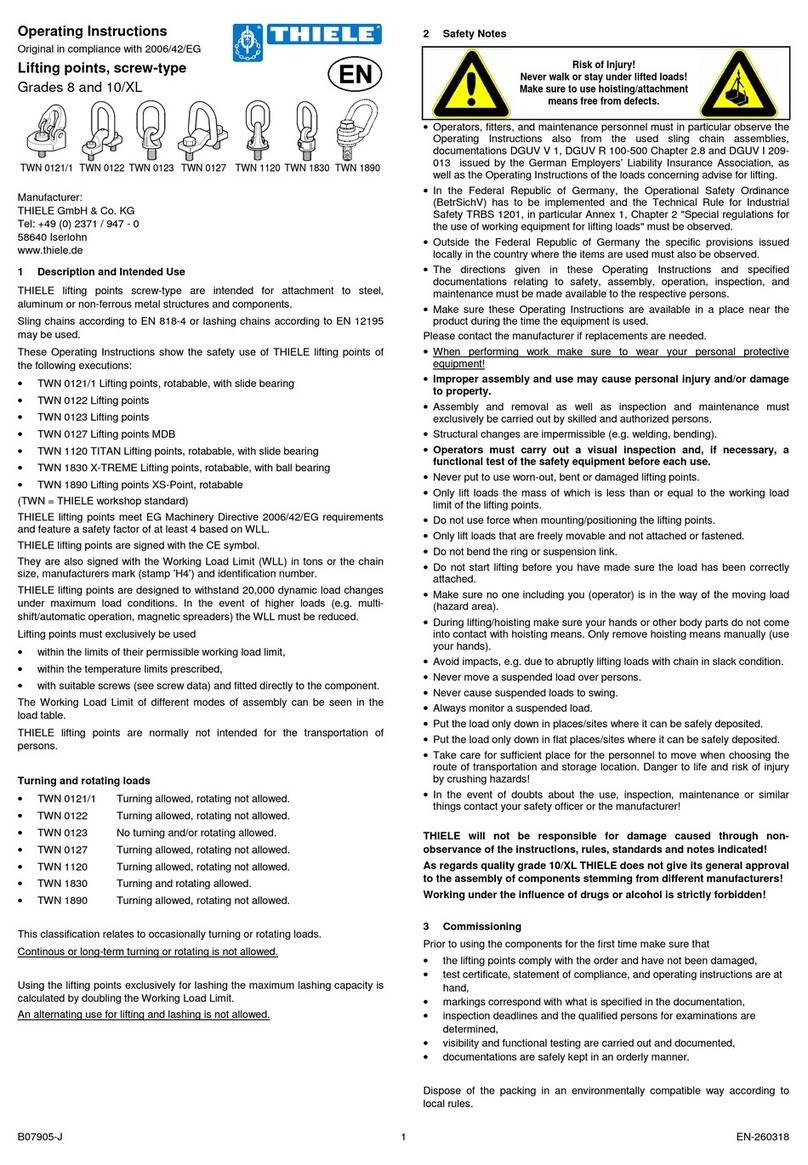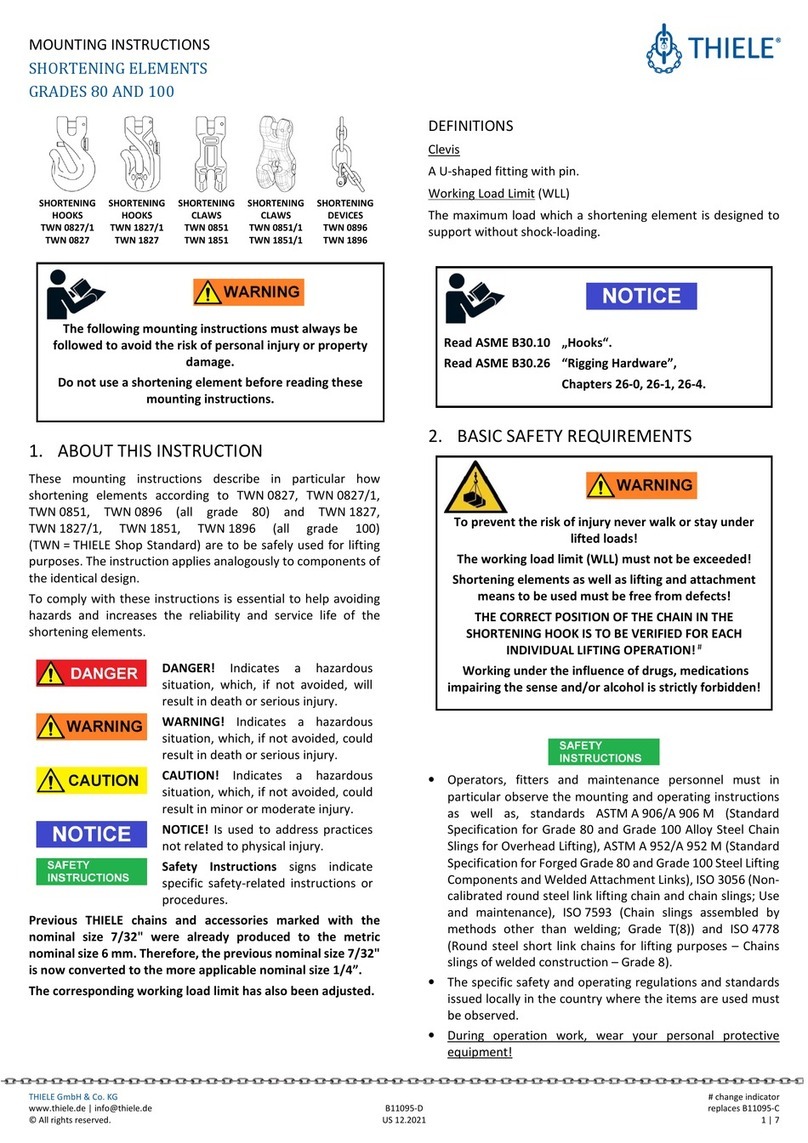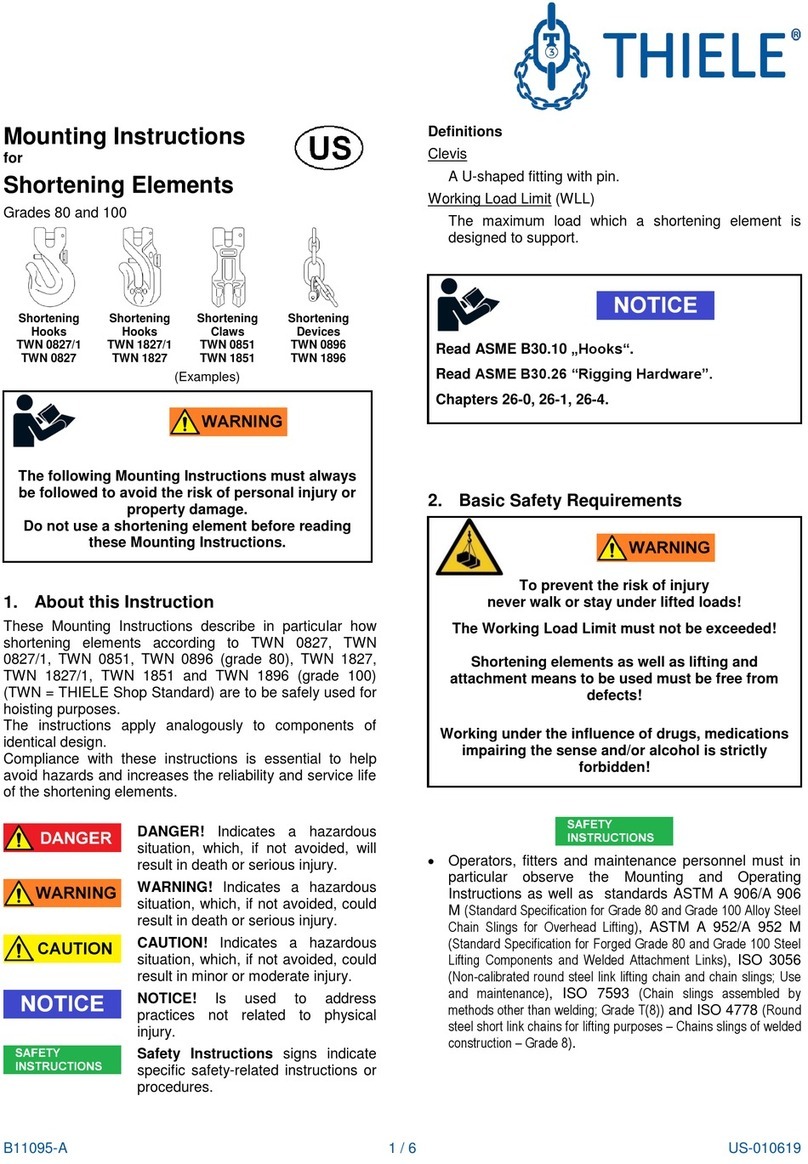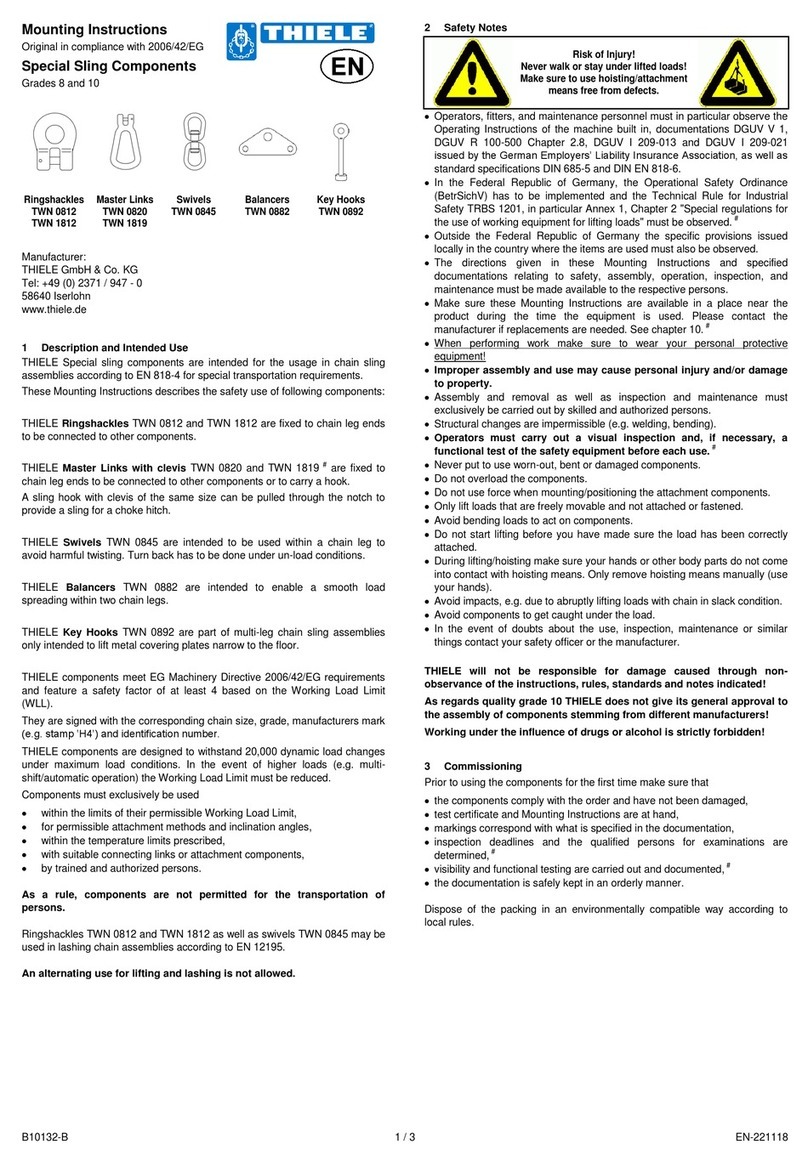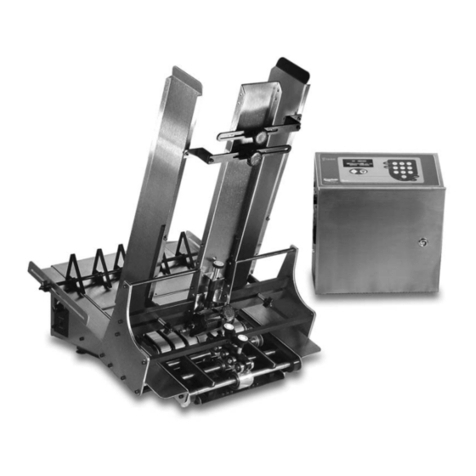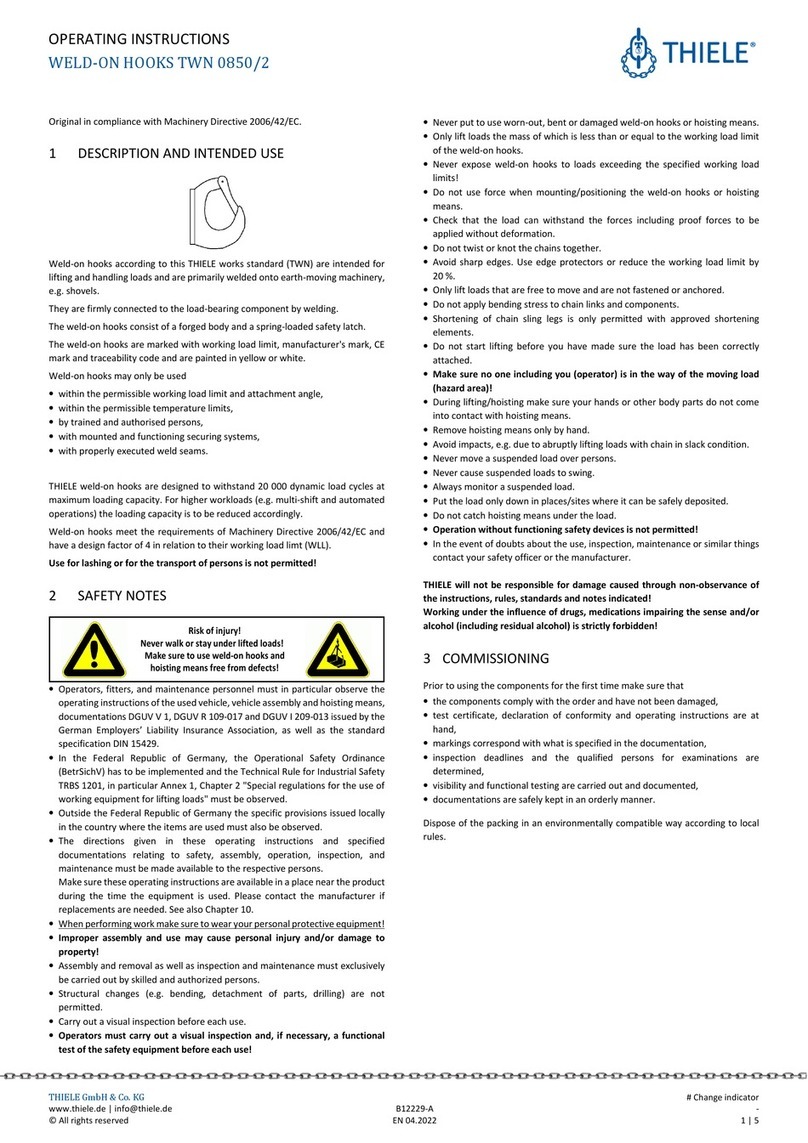
B10357-B 1 EN-190918
Mounting Instructions
Original in compliance with 2006/42/EG
Shortening Elements
Grades 8 and 10
Shortening
Hook
TWN 0827/1
TWN 0827
Shortening
Hook
TWN 1827/1
TWN 1827
Shortening
Claw
TWN 0851
TWN 1851
Shortening
Device
TWN 0896
Shortening
Device
TWN 1896
Manufacturer:
THIELE GmbH & Co. KG
Tel: +49 (0) 2371 / 947 - 0
58640 Iserlohn
www.thiele.de
1 Description and Intended Use
THIELE-Shortening elements (Shortening hooks, Shortening claws,
Shortening devices) are exclusively intented to shorten individual chain legs
within several sling chain assemblies according to EN 818-6.
Shortening elements must only be used within a single loaded chain leg.
Shortening elements must exclusively be used
within the limits of their permissible Working Load Limit,
for permissible attachment methods and inclination angles,
within the temperature limits prescribed,
by trained and authorized persons.
Shortening hooks with safety device can also be used within lashing chain
assemblies according EN 12195.
Any alternating use for lifting and lashing purposes is impermissible!
Shortening elements are as a rule not permitted for the transportation of
persons.
THIELE-Shortening elements meet EG Machinery Directive 2006/42/EG
requirements and feature a safety factor of at least 4 based on Working Load
Limit (WLL).
The shortening elements are designed to withstand 20 000 dynamic load
changes under maximum load conditions. In the event of higher loads (e.g.
multi-shift/automatic operation) the Working Load Limit (WLL) must be reduced
before the parts are put to use.
Shortening elements are marked with nominal chain size and quality grade,
manufacturer’s symbol and traceability code.
2 Safety Notes
Risk of injury!
Never walk or stay under lifted loads!
Make sure to use lifting or lashing
means free from defects.
Operators, fitters, and maintenance personnel must in particular observe the
Operating Instructions of the sling chain assembly into which the shortening
elements are to be installed, documentations DGUV V 1, DGUV R 100-500
Chapter 2.8, DGUV I 209-013 and DGUV I 209-021 issued by the German
Employers’ Liability Insurance Association as well as standard specifications
DIN 685-5 and DIN EN 818-6.
Outside the Federal Republic of Germany the specific provisions issued
locally in the country where the items are used must also be observed.
The directions given in these Mounting Instructions and specified
documentations relating to safety, assembly, operation, inspection and
maintenance must be made available to the respective persons.
Make sure these Mounting Instructions are available in a place near the
product during the time the equipment is used.
When performing work make sure to wear your personal protective
equipment!
Improper assembly and use may cause personal injury and/or damage
to property.
Assembly and removal as well as inspection and maintenance must
exclusively be carried out by skilled and authorized persons.
Structural changes are impermissible (e.g. welding, bending).
Operators must carry out a visual inspection and, if necessary, a
functional test of the safety equipment before each use.#
Never put to use worn-out, bent or damaged shortening elements.
Never expose shortening elements to loads exceeding the specified Working
Load Limit.
When using shortening elements without additional safety elements (e.g.
TWN 0827, TWN 1827 or TWN 0851), special care must be taken and the
correct position of the chain in the shortening element is to be verified for
each individual hoisting operation.
Shortening hooks must not be attached directly to loads, e.g. metal sheets.#
Only chain legs and shortening elements of the same nominal size and
grade may be connected.#
Safety elements must not be excessively stressed or strained operationally.
Do not use force when mounting/positioning the shortening elements.
Do not twist or knot the chains together.
In case of multi-leg sling chain assemblies never allow for inclination angles
of less than 15 ° and in excess of 60 °.
Avoid bending loads to act on chain links and shortening elements.
Make sure to use shortening/grab hooks or claws for chain shortening
purposes.
In case of shortening claws only put loads on the chain exiting the claw
pocket bottom.
During lifting/hoisting make sure your hands or other body parts do not come
into contact with hoisting means. Only remove hoisting means manually (use
your hands).
Avoid impacts, e.g. due to abruptly lifting loads with chain in slack condition.
Usage without working safety elements (cotter pins, dowel pins) is not
permissible.
Shortening elements must be allowed to move freely in all tensile directions.
In the event of doubts about the use, inspection, maintenance or similar
things contact your safety officer or the manufacturer!
THIELE will not be responsible for damage caused through non-
observance of the instructions, rules, standards and notes indicated!
As regards quality grade 10 THIELE does not give its general approval to
the assembly of components stemming from different manufacturers!
Working under the influence of drugs or alcohol is strictly forbidden!
3 Commissioning
Prior to using the parts for the first time make sure that
the parts comply with the order and have not been damaged,
test certificate, statement of compliance, and Mounting Instructions are at
hand,
markings correspond with what is specified in the documentation,
documentations are safely kept in an orderly manner.
Dispose of the packing in an environmentally compatible way according to
local rules.
4 Technical Data
Table include only article numbers of standard and not customized parts.
WLL = Working Load Limit
4.1 Shortening Hook TWN 0827/1, Grade 8
Execution TWN 0827 without safety pin
4.2 Shortening Hook TWN 1827/1, Grade 10
Execution TWN 1827 without safety pin
1) in preparation




